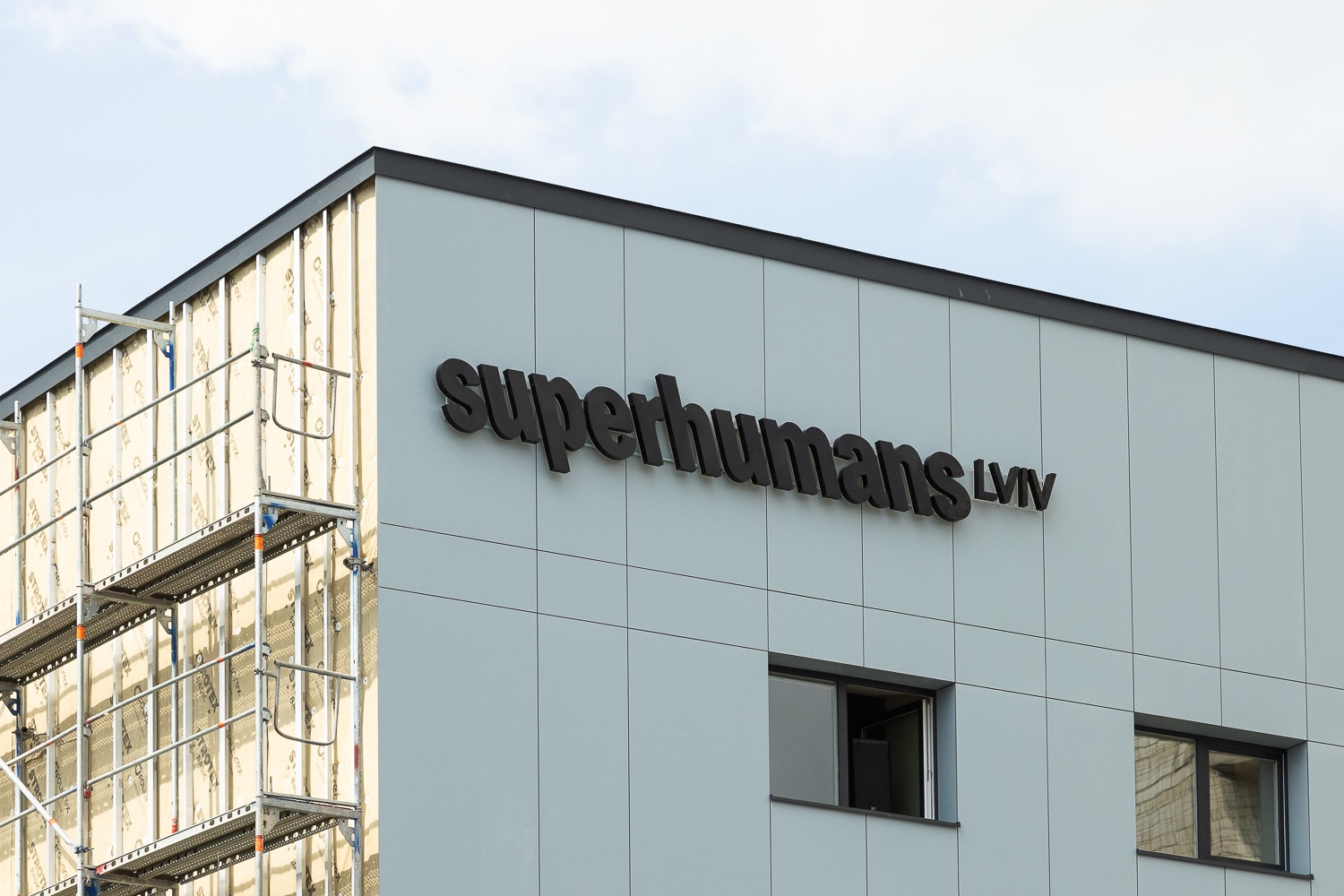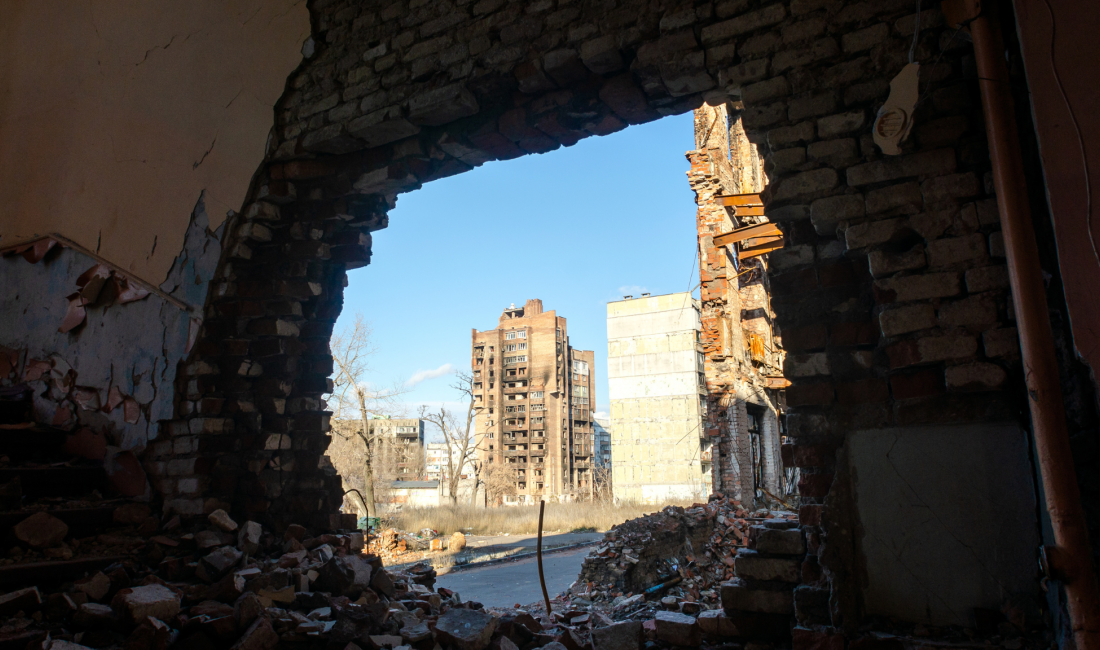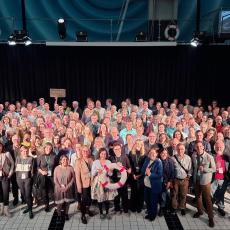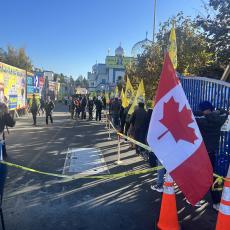With help from cities around the world, a democratic, "Locals First" model emerges.
Ukrainian translation. Russian translation
This essay by Joe Mathews, Democracy Local founder and Berggruen Institute fellow in Renovating Democracy, was published by Noema Magazine. Please read the whole essay here and subscribe here. Art also by Noema. Photo Creative Commons by Sofiia from Adobe Stock.
The most promising ideas today for reconstructing countries after war and disaster are coming from war-damaged Ukrainian municipalities. But will those municipalities ever get to use them?
It might seem strange, even perverse, to express optimism after more than three years of Russia’s war against Ukraine. The conflict has killed tens of thousands of Ukrainians, injured hundreds of thousands, and displaced millions. But the war has also inspired highly detailed and creative local and regional planning that promises to change how the world rebuilds itself after conflict and disaster.
The various local Ukraine strategies for rebuilding do not have a name, but the overall approach might best be called Locals First.
Since the Russian invasion in 2022, some of Ukraine’s local leaders and networks of their allies worldwide have discussed rebuilding in what would amount to two phases. First, everyday citizens would use democratic processes — from online tools to deliberative bodies like citizens’ assemblies — to make plans for their own localities. Second, reconstruction money would go directly to local governments, rather than via national governments and international aid groups, to enact those plans.
That might sound straightforward and logical, but it would be revolutionary for post-conflict and post-disaster reconstruction. Since World War I, national governments and other donors have typically handed reconstruction money over to other national governments, which dole it out in ways that serve the interests of national leaders. Meanwhile, the work of reconstruction is usually performed by favored corporations and NGOs, who largely ignore the ideas and needs of local people and authorities.
Local communities in conflict zones are thus twice victimized: First, they blow you up, then they steal from you. Post-war reconstruction in Iraq, Afghanistan, Cambodia and East Timor has tended to follow this model, which has kept much aid from ever reaching local communities. And post-war Ukraine could go down the same old extractive path. U.S. President Donald Trump and Ukrainian President Volodymyr Zelenskyy just signed a deal that gives American interests preference in extracting mineral wealth from Ukraine, without security guarantees. The agreement allows the U.S. to count any support for Ukraine’s military as fulfilling its pledges on reconstruction.
But Ukraine’s post-war future should be different — and locally designed. Indeed, it might have to be.
Locals Filling A National Void
As the global order falls apart, responsibility for governance is falling to local communities and their governments. The world’s national governments, the primary funders of post-conflict aid, are increasingly consumed by their own internal political fights. This isolationism and nationalization of politics leave less time for thoughtful global governance, including reconstruction initiatives overseas.
These global trends have put financial pledges and commitments to rebuild Ukraine in doubt.
The United States, once generous with aid and reconstruction promises, has threatened to withdraw support. The Trump administration’s dismembering of the U.S. Agency for International Development (USAID) effectively cut support for mental health, education, and elderly services in Ukrainian cities. In war matters, the Trump administration has often sided with the Russian aggressors, making it less likely that Vladimir Putin’s government will ever pay for the hundreds of billions of Euros of damage his war did to local communities.
The European Union, which previously pledged up to $54 billion to Ukraine’s recovery and reconstruction for the war, has its own problems, including massive new expenses of paying for its own security as America retreats from the Atlantic alliance. And the United Kingdom’s billions in commitments could become a casualty of that country’s polarized politics and budget cuts.
European and other international donors may be reluctant to funnel aid through Ukraine’s national government, viewed as too compromised and corrupt to lead the construction of Europe’s second-largest country.
But trust in Ukraine’s local governments and officials remains remarkably high, and with good reason.
Lower Poverty, Better Democracy
In 2014, Ukraine forced out its Russia-allied president, Viktor Fedorovych Yanukovych, and he fled the country. This pro-democracy Maidan Revolution, or Revolution of Dignity, which began in 2013, spurred desire among Ukrainians to reduce the Russian influence in their government. One target became the heavily centralized administration of the country that dated to the Soviet period.
What followed was perhaps the world’s most successful 21st-century decentralization of national government power.
Ironically, “Децентралізація” (“Decentralization”) started as a project of the national government. Local jurisdictions were combined and reorganized into 1,469 larger municipalities.
Once these municipalities were formed, the national government granted them new administrative powers and enhanced funding and fiscal authority. A majority of income tax money was allocated to municipalities, and Ukraine set up a new State Fund of Regional Development.
Municipalities, with more cash and new powers, went on a development tear between 2016 and 2020. By that decade’s end, 640 new medical centers or clinics were built in Ukrainian villages (many in old huts previously without water or sewage, according to one report in the Euromaidan Press newspaper). About 400 sports facilities were also built, and hundreds of schools and roads were reconstructed.
The development brought more prosperity and funded improved government services. Across Ukraine, a network of local “one-stop-shop” centers emerged. These would handle a staggeringly wide array of services — biometric passports or national ID cards, company registrations, real estate transfers, and the provision of benefits, pensions, permits and certificates for births, deaths and marriages.
Decentralization vastly improved the prospects of everyday Ukrainians. From 2014 to 2019, the percentage of the population with incomes below subsistence levels fell from 52% to 23%. The percentage of Ukrainians with internet access increased by 30%.
Empowered local governments were also more democratic. Municipalities pioneered digital tools for democracy, started youth councils, and embraced participatory budgeting to allow citizens to decide on spending. At the end of 2021, the Southern Buh river cities of Khmelnytskyi and Vinnytsia finished first and third, respectively, in a global contest for innovation in government transparency. In 2020, Mariupol, then a bustling city of 439,500 on the Sea of Azov in the country’s southeast, took home an award from Transparency International for its transparent and accountable model of sharing governance power with local organizations.
Decentralization Goes To War
Wars between nations have long been forces for centralization, with power going to the national and military leaders overseeing the fight. More than two centuries ago, Carl von Clausewitz, the Prussian military theorist, explained why: “To achieve victory, we must mass our forces at the hub of all power and movement.”
But the Ukraine war, arriving in the midst of local governance successes, has worked differently. It has reinforced, and in some ways accelerated, the decentralization of power.
Responsibility and power have been split. Ukraine’s national government assumed emergency powers and has led the prosecution of the war. But with the national government consumed by the war effort, other governance responsibilities have ended up in local hands.
Indeed, the war has produced an unexpected surge in civic engagement and civil society. Everyday citizens, working locally, have created new transparency regimes and advanced environmental protections.
Local people and officials have also assumed war duties. They’ve fed soldiers and tracked Russian war crimes. Local governments, businesses and volunteers, inside and outside Ukraine, now buy and donate drones, cars and ammunition to the armed forces.
Local emergency services have held up remarkably well through bombings and blackouts. Municipalities have organized care-giving for the wounded. Such local courage in wartime quickly showed why post-war reconstruction should be led locally. “Clearly, leaders who have managed local response systems are well equipped to identify local needs and mobilize available resources for future targeted reconstruction projects,” Zachary Popovich and Michael Druckman, Ukraine experts then at the International Republican Institute, wrote for the Atlantic Council in 2023. “For this reason, it is crucial that Ukraine’s nascent reconstruction strategies incorporate local leaders and mayors as primary actors charged with directing and managing redevelopment initiatives.”
In this conclusion, the Atlantic Council was hardly alone. The World Urban Forum has created planning tools for locally driven recovery and called for municipalities and local communities to take “ownership” of reconstruction. The Organization for Economic Co-operation and Development (OECD) has recommended locally focused development and encouraged the creation of a “robust municipal performance measurement framework” to track and manage local capacity, as well as “peer-to-peer” exchanges between subnational governments inside and outside Ukraine on the country’s reconstruction.
Lugano Principles
Beginning in 2017, Ukraine’s governance changes were supported by international experts who met at annual Ukraine Reform Conferences. After the Russian invasion, the reform conference was renamed the Ukraine Recovery Conference.
So, quite naturally, the need to put local governments and civil society at the center of reconstruction was a major theme of meetings and conferences on Ukraine’s recovery. The 2022 Ukraine Recovery Conference, held in Lugano, Switzerland, produced the “Lugano Principles.” The fourth principle says: “The recovery process has to be a whole-of-society effort, rooted in democratic participation by the population, including those displaced or returning from abroad, local self-governance and effective decentralization.”
That statement has become a mantra for those seeking local leadership of Ukraine’s reconstruction.
Estimates of postwar reconstruction costs in Ukraine are nearly three times larger than the country’s 2021 gross domestic product — far more money than the national government has ever handled, wrote University of Chicago economist and political scientist Roger Myerson, a Nobel laureate, in the e-book “Supporting Ukraine: More Critical than Ever.”
Myerson, who studies global conflict, also wrote in this 2023 publication that if money for reconstruction went primarily to business people with connections to the national government, the result could be to create a new class of oligarchs to dominate Ukraine for many years to come.” Much better, he suggests, is to “spread the profits of reconstruction among the thousands of businesspeople who have connections to their local mayor’s office.”
Twinning With Other Cities
Some of the most aggressive supporters of “Locals First” reconstruction can be found outside Ukraine, in municipalities that are “city twins” of Ukrainian localities.
As local communities, especially across Europe, watched the war against Ukraine and the destruction of its local communities, many rallied to help their Ukrainian partners. One very popular method has been for cities to “twin” with a Ukrainian counterpart. In normal times, “twinnings,” or sister-city partners, are considered friendly cultural or trade agreements that might produce a joint festival or one-off project.
But in moments of crisis, they can become life-saving bilateral partnerships. And fittingly, their history is rooted in depression and war.
The first great twinning launched between Toledo, Ohio, and Toledo, Spain, in the 1930s, spawned a network of support between a Midwest industrial city suffering from the Depression and an Iberian river city suffering from civil war. The idea of twinning became even more popular in World War II when Coventry, a West Midlands city bombed during the Blitz, established a partnership with besieged Stalingrad (now Volgograd) in 1942. During that twinning, Coventry women collected six pence from each local resident to send to their Soviet counterparts. (The Coventry-Volgograd twinning relationship endured until 2022, when the British city suspended it after Russia attacked Ukraine.)
Twinnings had a revival during the Balkan wars. The most famous such twinning came in the early 1990s when Barcelona declared Sarajevo its 11th district and allocated resources to the besieged Bosnian capital.
For the three years of siege, Barcelona’s support came in the form of food and medicine. When the siege lifted, Barcelona sent planners and funds to reconstruct two neighborhoods of Sarajevo. The partnership endures to this day, with Sarajevo and Barcelona exchanging people and support under the auspices of the District 11 City to City Association.
The Association of Local Democracy Agencies, which was first organized by local-level activists to establish twinnings during and after the Balkan wars, has been doing similar work in Ukraine. European institutions and the OECD have encouraged such partnerships.
And so, in Ukraine, twinnings are everywhere. Kyiv alone has bilateral twinnings with Warsaw, Paris, Rome, Lyon, Oslo, Edinburgh, Hamburg and Mexico City. Lviv is twinned with Tartu and Winnipeg, Odesa with Marseille, Mykolaiv with Glasgow.
Many of these relationships are limited expressions of solidarity, but some cities have sent money and people to build structures and plan deeper reconstruction. Hamburg, which is both city and state, is assisting Kyiv with reconstruction. The Polish cities of Opole and Radom have sent multiple cargoes of humanitarian aid to Vinnytsia, in south-central Ukraine. The small city of Lozova, despite being on the frontlines of the Kharkiv oblast, has been working on economic plans and joint projects under a twinning with Edward River Council in New South Wales, Australia.
Post-War Reconstruction Before The War Is Over
With so many encouraging friends and so many urgent needs, some Ukrainian cities and towns have decided not to wait for the war’s end to begin reconstruction. The progress is strongest in western Ukraine, furthest away from the fighting.
Lviv, a beautiful European-style city of 710,000 just 50 miles from the Polish border, has been building housing to accommodate tens of thousands of additional residents from other parts of Ukraine. As part of a transit program for Ukrainian cities funded by the European Infrastructure Bank, it’s been adding to its transport system, including lower-floor train cars to accommodate the wheelchairs of people injured in war. Lviv is also rapidly building new and larger health infrastructure, the showpiece of which is the Superhumans Center, an orthopedic clinic opened in 2023 for the treatment and rehab of war victims who use prostheses due to amputations.
n Mykolaiv, home to 465,000 people on the Black Sea, the regional governor, Vitalli Oleksandrovych Kim, has led an aggressive rebuilding effort to produce seven new educational facilities and three medical ones. Mykolaiv also managed to complete a wind farm despite nearby fighting. The projects have been funded by international supporters and benefited from partnerships with governments in Latvia and Denmark.
One hundred miles southeast of Lviv, Ivano-Frankivsk — the name for both a region of 1.3 million and its leading city of 238,000 — has embraced reconstruction that emphasizes modernity and creativity. The centerpiece there is an innovation center on the site of an old Soviet gas plant, a project that began before the war. To foster collaborations, the center now combines government offices (including an office of digital transformation), businesses, a terrific gym, and a publicly owned restaurant called Urban Space 100. The city has also remade streets to protect pedestrians and make mobility easier for people with disabilities.
With so many projects in place, Ivano-Frankivsk has become a popular place for other Ukrainian cities to meet and discuss their own rebuilding plans.
And there are so many plans to discuss. Even evacuated cities that seem likely to be lost to Russia in a peace agreement are busily planning to rebuild themselves someday. The most ambitious planner may be Mariupol’s mayor in exile, Vadym Boychenko. When I ran into him in Barcelona, where he was attending a meeting of the European Association for Local Democracy, he started talking about plans that his city and its neighbors have for a new regional transportation system and more sustainable regional development.
“We have plans because we are realistic,” he told me through an interpreter. “Yes, they have killed twice as many Mariupol people as when Mariupol was under occupation in the Second World War. Yes, so many people have left. But we were doing so well before 2022 … People wanted to live and work in Mariupol. And they will want to do so again.”
Cities themselves are hardly the only ones with reconstruction plans. A mix of companies and NGOs have plans to rebuild badly damaged cities or even build new ones.
The German Marshall Fund has established the Ukraine Cities Partnership for Sustainable Local Recovery, which has brought together businesses, research institutions, NGOs, city associations and local governments across Europe and the U.S. to advise and assist cities on recovery. The German Marshall Fund is also in the process of selecting as many as three smaller cities — with populations of 100,000 less — that have seen substantial destruction, with the goal of rebuilding them as model cities.
The goals of such a city-making process go beyond rebuilding what was lost to the war. Localities are also eager to replace aging, Soviet-era infrastructure. Ukraine municipalities want new 21st-century things: integrated regional transportation systems, more sustainable economic development, better health and environmental bureaucracies, and new kinds of support for the poor.
Wanted: People To Return & Rebuild
Of course, skepticism about plans to rebuild after a war that is not yet over is natural, even healthy. Among the skeptics are Ukrainians themselves and those who lead municipalities.
After three years of war, local revenues are diminished. Too many Ukrainians have left their hometowns; cities will need their most skilled and educated citizens to return to realize their reconstruction dreams. Poorer communities may be left behind in the reconstruction surge. Smaller Ukrainian municipalities — as many as one-quarter of all municipalities, according to an OECD survey — report lacking the capacity in finance, technology and people, to create and execute local development plans.
Even surmounting such challenges won’t guarantee the reconstruction of local Ukrainian dreams. The country has two powerful and determined enemies — Putin and his ally, Trump. For all its talk of cease-fires, the U.S. administration often seems to be advancing Russia’s war aims. One of those aims appears to be deterring the successful, democratic, local reconstruction of Ukraine that would stand as an open rebuke to Russia’s highly centralized, authoritarian model.
Peace Begins Here
In recent months, while reaching out to Ukrainian local planners and dreamers, I heard one message: We will rebuild ourselves. We are not abandoning plans, no matter what the U.S. administration or European countries do or promise. Ukraine’s allies worldwide say similar things and suggest they may have to create new tools to jointly finance Ukraine’s reconstruction.
This means that even a negotiated end to the war may not be the end of the conflict. Reconstruction may become its own new war, a contest of influence between Russian sabotage, Trumpian efforts to extract Ukrainian resources (including through a new deal between the U.S. and Ukraine’s national government), and the joint efforts of Europe and world cities to help their Ukrainian counterparts build brighter futures.
Preparations are being made for such a conflict. Last year, Jan van Zanen, the mayor of The Hague, assumed the presidency of the world’s largest municipal organization, United Cities and Local Governments. He has begun a global campaign, under the banner, “Peace Begins Here: Local Solutions for Conflict,” in which cities and other local governments commit to protecting themselves and each other from violence.
Last year, van Zanen traveled to Kyiv for a meeting with 15 Ukrainian cities, where he called collective post-conflict rebuilding and peacemaking by localities an imperative, not a choice. “In times of crisis, collaboration is not just beneficial,” he said.
A Lesson From Slavutych
Van Zanen’s campaign emphasizes that municipal peace and reconstruction must be democratic. But how can democracy be practiced safely during war?
Two Ukrainian cities just answered that question directly. Late last year, two smaller cities in the Ukrainian north hosted citizens’ assemblies, processes in which representative groups of everyday citizens convene to solve thorny problems.
These were test cases. Such assemblies are likely to be used as tools of local decision-making on reconstruction plans and recovery projects around the country. The local city councils in the two cities organized the assemblies, with funding from the Council of Europe, a membership organization of 46 European states (the EU has just 27 members) committed to democracy.
One assembly took place in Slavutych, which itself is a post-disaster reconstruction project. The town of 24,000 was built for personnel of the Chernobyl Nuclear Power Plant after the 1986 disaster. In 2022, Russian troops seized a hospital and kidnapped the mayor, but resident protests forced Russia’s retreat and the mayor’s return.
Slavutych, a few miles from the country’s border with Belarus, has become another gathering place for local governments planning for the future. Last spring, it hosted an “Unbreakable Ukraine” forum of “Mayors for Economic Growth.” Its citizens’ assembly focused on one aspect of governance and rebuilding: improving waste management. The assembly’s recommendations to the city included a mix of government actions and changes in how households sort their own waste.
The other assembly, in Zvyahel, an administrative center of 55,000 northwest of Kyiv, focused on a broader topic: “creating urban spaces as public locations for social interaction and recovery.” That assembly’s recommendations, adopted by the city in December, established working groups for eight recovery-related initiatives and a new civil society organization to secure funding.
Both assemblies were conducted during wartime, but the gatherings and the follow-up debates on implementing recommendations have proceeded peacefully and without incident.
These twin successes provided a proof of concept for Ukrainian towns determined to control their own rebuilding. Citizens’ assemblies and other resident-led processes can be used to guide reconstruction. Ukraine could be rebuilt, locals first.
A full rebuild could be a long way off, with Putin stepping up attacks even as he talks of ceasefires.
Or such a rebuild could be near — via an extended ceasefire or the U.S.-Ukraine mineral deal turning into a larger peace deal, though both prospects seem distant as I write this.
Whatever the outcome in Ukraine, the many local plans for rebuilding point to a very different future for how human communities respond to disaster and conflict. Ukraine’s model — and The Hague Mayor van Zanen’s campaign for peace and local reconstruction — is being watched with interest and envy. The need for Locals First is urgent, and Ukraine provides a model.
In Ethiopia, recovering from civil war, the surge in early monetary pledges to Ukraine has drawn comparisons with the very limited reconstruction money reaching the Tigray capital of Mekele and other damaged communities.
Solidarity is strong between today’s targets of war and tomorrow’s potential victims. Taiwan’s government, wary of Chinese aggression, has been working via Lithuania’s government and NGOs to assist Ukraine’s local rebuilding. (Ukraine has no diplomatic relations with Taiwan.) Taiwanese entities have already paid for the reconstruction of a kindergarten in rural Borodyanka, outside Kyiv.
If the latest war between Israel and Hamas ever ends, the rebuilding of Gaza ought to be a Locals First effort. Gaza City has vital twinning relationships with reconstruction champion Barcelona and the European democracy capital, Cascais in Portugal, as well as Dubai, Brazil’s capital of Brasilia and other localities that might assist with funding or personnel. In the West Bank, the former mayor of Ramallah, Musa Hadid, famous from a 2020 documentary about his city hall tenure, has built twinning relationships with Dublin, Johannesburg and Oxford that could be helpful to reconstruction.
In the meantime, the next Ukraine Recovery Conference is scheduled for July 10-11 in Rome. Hundreds of local officials, from inside and outside Ukraine, should join the talks, which could center on how to finance local and regional construction. Many of these actors are members of a global Coalition of Sustainable Municipalities formed last year, and among the supporters are German and European localities. The conference has pledged to help find a partner city — a twin — for every single municipality in Ukraine.
The hope is that Ukraine’s reconstruction may no longer depend on warring nation-states and institutions of the fading global order. Soon, perhaps, reconstruction will be a do-it-yourself project, done locally, with the aid of allies in local communities everywhere.





